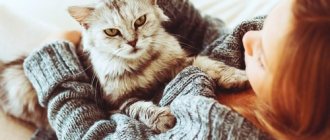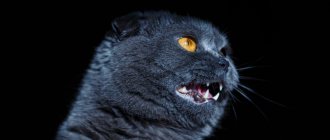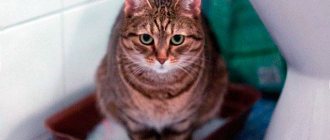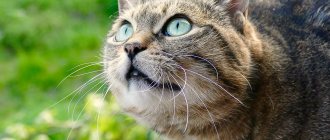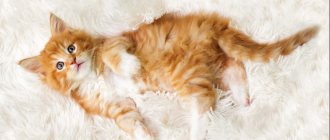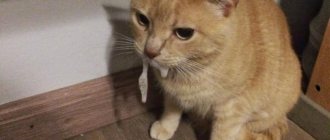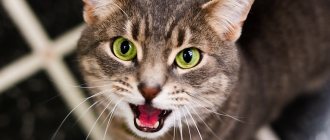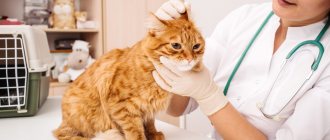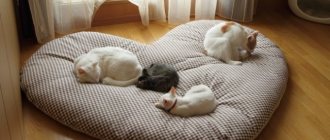8482Administration
3
Urinary incontinence in a cat, which owners often perceive as hooliganism on the part of the animal, is actually a sign of a health problem in a furry or hairless pet. To eliminate this unpleasant phenomenon, the cat must receive high-quality medical care, for which it should be shown to a veterinarian. If this is not done, the disease that caused the incontinence will continue to progress and may lead to the death of the sick cat. Provided that therapy begins in a timely manner, the likelihood that the problem will be eliminated completely is very high.
Reasons for appearance
Metabolic disorders are a common cause of urinary incontinence.
The course and development of uncontrolled urination directly depends on the disease or disorder in the functioning of the body that caused the appearance of this negative symptom.
We suggest you read: My cat has white worms in his stool, what should I do?
One of the main factors contributing to the appearance of incontinence in a pet is obesity. In addition, involuntary urination can occur after a pet is neutered, but this is quite rare.
In addition to the above, there are a number of the most common factors that can cause incontinence:
- congenital defects in the structure of internal organs - lead to the appearance of incontinence from childhood;
- frequent stressful situations;
- diabetes;
- inflammatory processes in the spinal cord or brain;
- disturbances in the functioning of the central nervous system;
- the presence of various infectious diseases, for example, cystitis;
- malignant and benign tumors;
- injuries to the tail, pelvis or spine;
- metabolic disorders,
- the presence of urolithiasis caused by feeding the pet low-quality food;
- complication after surgery.
In addition, incontinence is sometimes detected in individuals who have given birth, but most often this is a temporary phenomenon. Also, in old cats, due to age-related changes in the body and loss of elasticity of the urinary canals, involuntary urination may occur.
Complex therapy
If the disease was caused by disorders of the nervous system, then a comprehensive solution to the problem will be required. The veterinarian finds out the reasons that caused malfunctions in the spinal cord and brain. Based on the data obtained, therapy is carried out.
Sometimes the treatment provided does not bring the desired results. This situation is possible if the breeder turned to a doctor for help too late, or the pet is already too old.
Types of urinary incontinence in cats
There are the following types of urinary incontinence in cats:
- Leakage : The sphincter fails to control the flow of urine. Urine constantly flows or is released in drops. They are absorbed into the carpet or sofa fabric and are invisible. Pathology is detected by the presence of an ammonia odor. The intensity of the leakage increases when the animal moves.
- Stress : joy or fear is accompanied by involuntary urination.
- Urinary urgency occurs suddenly. The animal does not have time to get to the tray, worries that an embarrassment has happened to it, but is unable to do anything.
Be sure to read: A cat often burps: causes, symptoms, what to do when vomiting after eating, prevention, what not to do
What to do after recovery
My cat has urinary incontinence, what should I do?
First of all, the pet must be shown to a doctor. The specialist will take all the necessary tests, conduct an external examination and ask the owner about the cat’s behavior and lifestyle. Based on the collected medical history, a diagnosis of “urinary incontinence in a cat” can be made. Treatment will depend on the reasons that caused it. A cat's urine may leak for a variety of reasons. It is important to take preventive measures to prevent such an unpleasant situation. Experts give a number of recommendations that are important to follow:
- select only high-quality food for your pet that meets its age, health status and needs;
- regularly treat against helminthic infestation;
- limit uncontrolled presence outside the home;
- regularly visit a doctor;
- Do not give your pet economy-class food if the cat is neutered or has chronic diseases.
If the breeder provides the pet with high-quality food and proper care, then the problem can be avoided.
During the treatment and recovery period, it is necessary to provide the pet with complete rest. The cat should have its own place in a secluded corner. It is important not to scold the animal for mistakes, but to provide the opportunity to go to the toilet in many places in the house.
During the recovery period, maintaining hygiene is extremely important. If a bacterial infection has been detected, re-infection is possible through the litter.
Signs of urinary incontinence are varied, but with proper attention to the animal, they are not difficult to notice. Symptoms manifest themselves in:
- Regular moisture of the cat's coat in the area of the hind legs, belly and tail;
- The presence of wet spots in the animal’s resting areas;
- The consistency of urine changes - an unpleasant odor, mucus, blood, sand appears;
- Unintentional urination. The animal begins to walk outside the tray, and there is obvious anxiety and fear;
- Inflammatory processes on the skin in the area of the urethra;
- Damp fur around the area where urine is released.
The cause of urinary incontinence is determined based on history, clinical signs and laboratory tests.
Self-medication for these symptoms can harm the animal, significantly compromising its health.
Cats often don't notice urine leakage.
Most often, symptoms indicate the root cause of involuntary urine loss. Experts identify a number of signs indicating the presence of incontinence in an animal:
- plaintive meowing – characterizes the presence of an inflammatory disease;
- sudden changes in behavior - severe anxiety, fear, depression;
- uncontrolled urinary incontinence in cats occurs during sleep;
- constant wetting of the fur on the inside of the thigh;
- the presence of a wet spot in a different place where the pet recently lay;
- inflammation around the animal’s genitals indicates chronic incontinence.
It is not recommended to show too strong a reaction to such behavior - this will not solve the problem, but will lead to severe fright of the pet, as a result of which it will constantly hide. First of all, it is necessary to conduct a diagnosis and find out the most accurate cause of this symptom.
It is impossible not to notice urinary incontinence in a pet. Wet spots remain in those places where the cat has just stood or sat, and she always has wet fur on the inner thighs, under the tail.
In addition, the animal’s behavior changes. Cats are naturally very clean animals, trained to use a litter tray from an early age. With involuntary urine discharge, embarrassment can happen at any time - during sleep or wakefulness, when the cat simply does not have time to run to its toilet.
Realizing that she made a puddle in the wrong place, the poor guy looks scared and restless. And if the owners begin to swear, express indignation at the offense, and even more so resort to punitive measures, then this becomes very stressful for the animal.
Based on the degree of urine output, several forms of incontinence are distinguished:
- Undermining. Urine is released involuntarily in a small volume, dropwise, after physical exertion. The general condition of the cat is unsatisfactory, even if he has undergone appropriate treatment.
- Constant selection. Urine leaks every time after any movement or change in the position of the cat’s body. The back and stomach are constantly wet. The litter where he rests is thoroughly saturated with urine. The animal smells bad and, experiencing severe discomfort, constantly licks itself.
- Urgentnaya. The cat does not feel the urge to urinate. Because of this, the bladder becomes full and urine leaks randomly. This worries the pet, who does not understand what is happening to him. He needs to be reassured, but under no circumstances should he be scolded.
- Stressful. Urine flows out in different volumes - from a few drops to copious discharge.
Regardless of how often and in what volume the cat excretes urine, you should immediately take your pet to a veterinary clinic, where he will be examined by a veterinarian.
Urinary incontinence in cats is divided into several types, according to the nature of the manifestations:
- The cat's urine is constantly flowing in small drops. The cause of this disease is a weakening of the muscles that control the sphincter. Another reason is weak bladder muscles that are unable to stretch and contract.
- The inability to tolerate is called urge incontinence. Urine excretion occurs spontaneously as soon as the pet feels the urge. Such animals do not have time to reach the tray, but strive towards it.
- Stress incontinence has nothing to do with psychological stress. This refers to a sharp increase in pressure in the abdominal cavity, which leads to urination. In such animals, discharge can occur, for example, from a sharp jump.
- Reflex discharge occurs when the pet does not feel the urge to pee. Emptying occurs reflexively.
- Nocturnal inability to hold urine, as the name suggests, occurs at night when the pet is sleeping and cannot control the urge to pee.
If there is any suspicion of a disease, the owner should contact a veterinarian.
Regular dampness of the fur in the tail area and wet spots on the sleeping area indicate a problem.
Involuntary urination in most cases is a consequence of pathologies of the urinary system and other internal organs. If your pet constantly leaks urine due to an illness, then the following symptoms are recorded:
- regular moisture in the fur in the area of the hind legs, tail and belly;
- wet spots near and on the animal’s sleeping place;
- unpleasant smell of urine;
- mucus, sand, or blood in the urine;
- constantly involuntarily leaks from the cat’s genitals, which is why the pet has more frequent misfires and trips past the litter box;
- restless state;
- inflammatory reaction on the skin near the urethra;
- refusal to eat.
Defecation disorders
The nature of the disturbance in the defecation process depends on the level at which the spinal cord was damaged:
- In some cats, food begins to move through the intestines more slowly than it should.
- In others, the functioning of the rectal sphincters is disrupted.
- Some animals simply stop feeling the impulses coming from an overcrowded intestine. They don't strain their abdominal wall to poop; the anal sphincter remains contracted.
- And very rarely there is complete fecal incontinence.
If you are not satisfied with the situation in which the cat poops on its own, but unpredictably (feces fall out while the animal moves around the apartment), you can take control of the defecation process. To do this, the rectum is stimulated with a finger, which causes its reflex emptying.
The owners' task is to ensure that the pet poops at least once every 2-3 days, and that the feces remain soft enough.
What to do if your cat has urinary incontinence?
Sometimes urinary incontinence occurs as a postpartum complication. The pathology resolves spontaneously. In all other situations, if incontinence is suspected, the cat is sent to the clinic for examination.
The veterinarian conducts an examination, takes blood for analysis, performs an ultrasound, makes a diagnosis and prescribes treatment. If surgery is indicated, it is performed in a clinic, and postoperative care is provided by the animal owner at home. If conservative treatment is required, follow the procedures prescribed by the veterinarian.
With urolithiasis, situations arise when it is necessary to insert a catheter to drain urine. If your cat is diagnosed with diabetes, you will need insulin therapy and a special diet that is low in carbohydrates and high in protein and fat.
Examination by a veterinarian
Kurilian bobtail, with documents and vaccinations, took a one-year-old, according to the advertisement. Since her arrival, she has been constantly diarrhea, the stool is brown, liquid, homogeneous without pieces, the consistency of thin sour cream, after a couple of weeks droplets of feces began to fall out when walking... the smell is very fetid... plus increased gas formation - we begin to massage the stomach - farts.
At the same time, his appetite is good, he is gaining weight, there is no vomiting, and he behaves actively. Within a week, the third eyelid fell out, but soon it passed. We put her on a rice diet with chicken meat (2 weeks) - her stool did not return to normal. We began to suspect a viral origin - soon our kitten, who was doing fine before her arrival, also began to diarrhea.
Injected with gamavit fosprenil - no changes in the cat, the kitten's diarrhea went away. We tried to inject the antibiotic tylosin - the stool began to lose even more, the stool acquired a dark green color (a week). Only after a two-day hunger strike was the stool more or less formed. The primary concern is incontinence - what could this be connected with? Of course, I would like to normalize the stool. And if you go to the clinic, what tests need to be taken in this situation?
The doctor needs to tell all the symptoms that the owner noticed. During the examination, the veterinarian will perform palpation, which can be used to identify large tumors and organ development abnormalities.
We invite you to read: The cat died: how to survive death and bury the animal
In case of incontinence and other urological disorders, a urine test will be prescribed, most often microscopy of the sediment will be required. Previously, we have already given a detailed explanation of a urine test for a cat. If necessary, ultrasound and x-rays are also performed.
Additional studies may be needed, such as a blood test, microflora culture, and analysis of renal epithelium in the cat’s urine.
Important: obvious neurogenic disorders such as injuries, tumors, spinal hernias, and urinary disorders are treated by eliminating these factors.
In cases of functional disorders, a complete and comprehensive examination cannot be avoided. Only a complete collection of all indicators will make it possible to correctly diagnose and correctly prescribe treatment.
During the examination, the veterinarian will recommend using special diapers for animals. There should always be a clean, absorbent diaper on the sleeping area. These care items are sold at any pet store.
Important: do not scold your pet for its inability to tolerate, do not punish it under any circumstances. A stressful situation will only harm the animal, but affection and care, on the contrary, will help cope with the disease.
Diagnostics in a veterinary clinic
To make a diagnosis, the veterinarian, in addition to a visual examination of the animal and anamnesis, conducts a number of diagnostic studies. These include urine analysis, blood biochemistry, pelvic x-ray, and urological ultrasound. Sometimes additional diagnostic methods are used.
Urine for analysis must be collected correctly, otherwise feces caught in the urine may affect the results of the study.
It is advisable that the material for analysis be taken directly by a specialist.
Urinary incontinence in cats: treatment at home
Recovery after surgery consists of treating surgical sutures and a gentle diet. Conservative treatment consists of eliminating the underlying disease. The therapeutic strategy includes dietary therapy and drug treatment.
Correcting the diet eliminates factors that provoke urinary tract irritation. All human food products are excluded, as well as treats containing waste from cutting meat and fish.
The veterinarian will tell you when you can adjust the composition of the natural diet, and in which cases you can use ready-made dietary food. In some cases, therapeutic nutrition is carried out until the clinical symptoms disappear, but sometimes lifelong use of ready-made dietary feeds will be required.
Medications
Medicines are used to eliminate the symptoms of the underlying disease.
The following groups of medicines are in demand:
- antibiotics;
- antispasmodics;
- anti-inflammatory drugs;
- analgesics;
- means that normalize the functioning of the sphincters and bladder.
Be sure to read: Diarrhea in a kitten: what to do, first aid, causes, treatment, medications and folk remedies
To improve the well-being of older animals with chronic renal failure, the oral remedy Semintra or analogs are prescribed.
Folk remedies
There are no traditional medicines that can have a positive effect in the treatment of urinary incontinence. However, the many years of experience of connoisseurs of medicinal herbs have been taken into account and, on its basis, drugs have been developed that are used in medicine and veterinary medicine. Urolex contains birch leaves; bearberry. goldenrod, horsetail.
The drug is used to treat urolithiasis, as well as inflammatory processes of the urinary tract 3 times a day for a month. The drugs Kot Erwin and Stop-Cystitis have a similar effect.
Medicines developed on the basis of traditional medicine can be used after consultation with a veterinarian.
Treatment
The onset of the disease is almost impossible to suspect, since there are no signs.
The disease manifests itself when more than 50% of the kidney tissue is affected. As a rule, a reason to think that a cat’s condition indicates a diagnosis of renal failure is an analysis of its recent behavior - changed preferences, unhealthy appearance and poor activity. 1. The cat comes to the water bowl more often, drinks a lot and pees more.
2. Decreased appetite and weight loss of the cat.
3. The cat has become calmer and plays less.
4. Periodic vomiting and diarrhea (as a result of intoxication).
5. The coat loses its shine, becomes dull, dry, and does not even out after ruffling.
6. The smell from your mouth takes on an ammonia-like hue (not everyone can recognize this smell).
7. The mucous membrane of the mouth is paler than usual, ulcers may form.
8. The nose has become paler.
9. Prolonged constipation (a symptom of dehydration).
10. In severe stages - swelling of the abdomen and paws.
With acute renal failure and chronic renal failure, the entire body suffers, so the disease is classified as life-threatening and requires immediate treatment with medications.
When the kidneys are working well, toxins, waste and toxic substances are eliminated from the body, there are no surges in blood pressure, and normal production of enzymes and some hormones occurs. The kidneys are involved in the formation of blood cells.
If the kidneys fail, the pressure drops, the heart is overloaded, anemia develops, the body is cluttered with toxins, the cat becomes lethargic, inactive, and vomits. The digestive system suffers greatly, hormonal levels change. Kidney dysfunction leads to a complete malfunction of the entire body.
Diagnostics
AKI or chronic renal failure can only be diagnosed by a veterinarian by passing a urine and blood test. A clear sign of kidney failure is the level of creatinine, as well as high levels of protein in the urine and the presence of pus (if an infection develops).
Acute renal failure in cats treatment, diagnosis, causes
Treatment must be supplemented with nutrition; this is adjunctive therapy. Because the cat refuses to eat, the body is severely depleted. Therefore, even force feeding is appropriate.
If the test shows a urea level of less than 20 mol/l, feeding very high quality wet food is acceptable. When the condition stabilizes, we can switch to premium dry food.
At 30 mol/liter, STRICTLY a protein-free diet based on sweetened foods and flour products. If the cat is not picky about food, bread, oatmeal pancakes, pasta with the addition of vegetable oil are suitable for her.
Mix 100 ml of purified water with the same amount of 2.5% fat milk, add sugar - a tablespoon and potato starch - 1 teaspoon. Boil everything, cool. Beat in a raw chicken egg and 1 crushed Mezim tablet.
Mix the mixture thoroughly and give the cat 5 ml through a syringe every hour. As soon as the vomiting decreases or disappears and the condition improves, you can increase the dose, while reducing the interval between feedings. When the condition normalizes, transfer the cat to wet food.
Treatment of kidney failure in cats must be carried out by a veterinarian. The effect of drugs should be monitored by collecting tests. At home, you will not provide help to the animal - arrogance will be fatal for the pet.
Bring your animal to the clinic regularly for control tests. By noticing the disease at an early stage, you can prevent the degeneration of kidney tissue and get by with supportive therapy. Special control must be provided to animals of the Persian breed.
Urinary incontinence (enuresis) can be more or less pronounced in an animal. In order to be able to notice this problem when the first symptoms appear, a person must be aware of the types of urinary incontinence in animals:
- Dripping - excretion of urine in minimal quantities, drop by drop;
- Constant - very frequent discharge of urine when changing body position and movements;
- Urgent - sudden urination that frightens the animal;
- Stressful - urine discharge during fear or stress.
Having noticed the presence of a problem, the owner should carefully observe the animal, and also determine the amount and volume of discharge from the pet. These data will greatly simplify the diagnosis of the disease, and, accordingly, subsequent treatment.
Some owners, having noticed urinary incontinence in cats, try to limit the animals' fluid intake. This should absolutely not be done, as such methods will cause dehydration in cats and the development of more serious diseases.
DETAILS: Chronic renal failure - causes, treatment and complications of renal failure
Some cats, due to their upbringing, go to the toilet in a place other than the one designated for this. And they can also take revenge, protest or express their indignation in this way. But urinary incontinence has certain symptoms with which you can easily distinguish a whim from an illness.
Signs of urinary incontinence:
- The process of urination becomes uncontrollable during sleep;
- The animal's behavior changes, it becomes fearful and depressed;
- The presence of wet spots in the place where the cat was sitting or lying, as well as wet fur in the area of the legs and abdomen;
- When the cat runs to the litter box, he constantly fails to keep up and a stream of urine follows him.
The occurrence of this pathology can cause a violent reaction on the part of the owners, as a result of which the animal will become frightened and hide.
The course of the pathology and its treatment largely depend on the causes that caused the problem. Very often, the cause of urinary incontinence is another disease, the elimination of which normalizes the process and the amount of urine produced.
Reasons that cause the problem:
- General infections, as well as infections of the genitourinary system: cystitis, nephritis, nephrosis, and so on.
- Congenital pathologies in the genitourinary system – cause problems with urination in kittens from birth. This problem is very difficult to diagnose; it is better to do an ultrasound of the internal organs and visit a veterinarian.
- Urolithiasis, which is caused by improper feeding: the use of cheap low-quality feed and mixing dry and natural food.
- Problems in the body's nervous system due to infections, inflammation of the brain, blows, bruises, spinal injuries, high blood pressure, and so on.
- Problems with the body's metabolic processes lead not only to problems in the urinary system, but also to excessive weight gain in the animal and the development of diabetes.
- Changes in the body as a result of age;
- Cats that have experienced childbirth very often suffer from incontinence;
- Paresis;
- Paralysis;
- Bladder spasm;
- Tumors;
- Injuries.
The complexity of the disease that accompanies urinary incontinence may vary. Therefore, your pet should be treated by a good specialist who has the proper knowledge of animal diseases and methods of their treatment.
Once the cause of urinary incontinence is discovered, your veterinarian will be able to prescribe the correct treatment for your cat.
Treatment methods for urinary incontinence depending on the disease that caused it:
- If infection is present, antibiotics must be used;
- To treat incontinence due to problems with excess weight, dietary adjustments and physical activity are required;
- If there are problems with the cat's nervous system, the pet should be carefully examined to determine the factors that led to health problems.
In some cases, treatment may not have a positive effect. As a rule, this statement applies to elderly cats. In order to avoid unpleasant moments associated with constant incontinence in a cat, you need to place trays in different places in the house or put a special diaper on your pet.
It is also recommended to cover furniture and carpets with oilcloths for a while until the animal’s urine output returns to normal. In any case, it is not recommended to use any incontinence medications on your own, as this can lead to disastrous consequences.
If your cat's urinary incontinence is caused by extreme stress, childbirth, or trauma, it may improve without medication. But in this case, proper care for the animal is simply necessary.
It is prohibited to use human incontinence products to treat a cat. This decision will not help the cat, and will also significantly worsen its condition.
Since enuresis causes severe stress in the animal, the owner must make every effort to surround the cat with attention and care. Such an attitude towards your pet will definitely have a positive effect on the effectiveness of treatment.
DETAILS: Preparing for an abdominal ultrasound - what you can eat and drink. Diet before abdominal ultrasound
The causes of kidney failure are divided into prerenal, renal and postrenal (Ren – lat. Kidney).
Renal causes are a dysfunction of the organ itself and its structural units - nephrons (glomeruli) due to microbial inflammation, kidney damage from toxic substances. In addition, the protein secreted by diseased kidneys further harms them, worsening chronic renal failure.
Separately, we should highlight diseases that cause renal renal failure, often even in older animals, such as polycystic kidney disease and amyloidosis. These diseases are more common in Persians and Abyssinian cats, respectively.
Prerenal ones are usually associated with decreased blood circulation (perfusion) of the kidneys - dehydration, blood loss, use of medications that lower blood pressure.
Postrenal causes are usually obstruction (blockage) of the urethra or, less commonly, ureters with stones (crystals and protein plugs). Reduced lumen of the urinary tract due to inflammation and post-traumatic strictures (narrowings) are also often a postrenal cause of renal failure.
Symptoms of chronic renal failure are usually: decreased appetite, reduced cat activity, thinness, deterioration in coat quality, and occasional vomiting. With further development of the disease, these symptoms intensify, and the animal often completely refuses food and water.
Treatment method and prognosis
In case of involuntary urine discharge, complex treatment is carried out. The scheme is drawn up individually, depending on the cause of the pathology, age, and condition of the animal.
The main treatment methods include:
- Antibiotic therapy. Relevant for identifying infections and bacteria in the genitourinary system. The drug is administered intramuscularly or intravenously.
- The use of medications to normalize metabolic processes in the body.
- Special diet (if the pet is overweight).
- Antispasmodics and painkillers (for urolithiasis).
- Drugs that strengthen the tone of the bladder walls and stimulate the activity of the sphincter.
The prognosis depends on the disease. So, if incontinence is associated with an infection in the body, then after appropriate treatment it goes away.
Unfortunately, in some cases it is no longer possible to get rid of this unpleasant disease. If the cat is old, then its weakened body cannot adequately respond to therapeutic measures. In addition, the tissues are not restored and rejuvenated, so urine will leak constantly and its volume will increase.
The only thing that remains for the owner to do is to come to terms with it and provide the pet with the most comfortable living conditions. You can place trays in different places in the apartment or put a diaper on the cat.
Causes of pathology
In order to carry out the correct treatment, it is important to accurately determine the reason why the cat does not hold urine. It is not uncommon for incontinence to occur as one of the symptoms of an underlying disease. The following can cause disturbances in the animal’s body :
- infectious lesions of the urinary system in any of its parts;
- congenital pathologies of the genitourinary system - in such a situation, the cat suffers from a problem from birth, which is clearly visible as the kitten grows. Incontinence in a very young child may not always be noticeable, since the cat is careful to maintain cleanliness in its den;
- Urolithiasis is the most common cause of incontinence in cats. Due to the presence of fractions of different sizes in the bladder and ureters, constant irritation of the bladder sphincter occurs, as a result of which urine is not retained;
- disturbances in the functioning of the spinal cord or brain due to inflammatory pathologies, injuries and high blood pressure. In such a situation, there is a disturbance in the conduction of nerve impulses and a change in the contractility of the bladder sphincter muscles. Because of this, incontinence of various types appears;
- metabolic failures - with this phenomenon, incontinence is combined with obesity and the appearance of diabetes mellitus. Most often, with such a disorder, urine only drips in with greater or less intensity;
- age-related changes in a cat’s body - when a pet ages, the functioning of systems and organs in its body is somewhat disrupted, and urine leaks due to muscle weakness. Incontinence is often permanent due to the inability of the sphincter to withstand the pressure exerted by urine;
- frequent births - if a cat gives birth more than once a year, its urinary system does not have time to recover, which is why the normal functioning of the bladder is seriously disrupted and persistent incontinence develops;
- spasm of the bladder muscles - most often urine involuntarily leaks out once;
- paralysis of the lower parts of the body, in which urine leaks constantly;
- traumatic injuries to the bladder - urine leaks to varying degrees;
- tumors in the urinary system, especially in the urethra and bladder.
Typically, urine is tested to make a diagnosis. It must be collected in compliance with the rules, otherwise the feces that get into it will change the indicators. It is better if not only the analysis, but also the collection of material is done by a veterinarian. Sometimes additional research may be required. Eliminating the cause of incontinence in an animal, depending on its type and the general condition in which the cat is, may be more difficult or easier.
© shutterstock
It is important to remember that the earlier therapy is started, the higher the likelihood of complete elimination of urinary incontinence in a cat. By triggering the illness of his pet, the owner increases his costs for treating the cat and reduces the likelihood of a favorable outcome. It is especially important to provide timely help to the kitten, since for him incontinence is a very alarming symptom, which is why a visit to the veterinarian cannot be postponed even for one day.
Preventing urinary incontinence in cats
Preventing pathology involves following the rules for keeping and feeding a cat. There should be no drafts in the room. The cat should not be bathed frequently, and if such a need arises, it should be thoroughly dried and allowed to dry before being released indoors.
It is necessary to decide on feeding - natural or ready-made food. You cannot alternately feed both. If you decide to change the type of feeding, this should be done gradually, over the course of a week.
The use of economy-class feeds unbalanced in amino acids and vitamins accelerates the development of chronic diseases that lead to inflammatory processes in the genitourinary area and urinary incontinence. Therefore, it is necessary to use ready-made food of at least premium class. The use of canned food and granules can be alternated.
Neutered animals should be fed prepared food for sterilized cats. Excess gonads alter metabolic processes and increase susceptibility to the formation of urinary stones. Sterilization at an early age causes the urinary ducts to stop growing and they remain narrow.
If urate salt precipitates, a grain of sand is formed. In animals with a normal width of the ureter, it skips. With a narrowed lumen, the stone gets stuck. An obstruction to the outflow of urine is formed. Urolithiasis (urolithiasis) develops.
Be sure to read:
What to do if the kitten cannot poop, how can you tell if the cat is constipated?
Additional diagnostics will be required to prescribe treatment. If struvite stones have formed, urine acidifying foods will be required. When oxalate stones are detected, the urine must be alkalized by selecting feed. Cats are transferred to specially developed medicinal food.
For pets predisposed to KSD, it is recommended to use bottled still water for drinking. Treats from the table must be stopped. Products that are unusual for cats contain substances that provoke the development of chronic diseases.
Obese cats are transferred to ready-made dietary food. If you limit the consumption of natural food, your pet will feel hungry and scream, begging for food. Diets for overweight animals contain a high percentage of dietary fiber, which limits consumption. The pet's body will receive fewer calories, but the animal will feel full.
Medicinal food has been developed for cats suffering from kidney disease, diabetes, and urolithiasis. However, a cat cannot be protected from one disease. This is old age. Older pets are switched to specialized food that allows them to feel satisfactory.
How do you know if you have incontinence?
As with any other health problem, urinary incontinence is accompanied by a number of signs that make it unmistakable:
- Drops or wells of urine when the cat stands up
- Stomach and legs are wet
- Strong smell
- Urine residue in unusual places
- Dermatitis
- Skin inflammation or disease
- Swelling of the penis or vulva
Sometimes a cat will urinate out of the box to show that it is feeling some discomfort, such as when it is suffering from a urinary infection, for example. This is why it is important to distinguish these warnings from the indiscriminate , erratic and involuntary urination that characterizes urinary incontinence.
Preventive measures
In order to prevent the occurrence of enuresis in a pet, it is important to exclude all factors and causes that have a positive effect on the development of this pathology. It is important to feed your cat properly and prevent injuries, falls and bruises. There should be no drafts or excessively low temperatures in the room where the cat is located.
Systematic examinations by a veterinarian for preventive purposes are the best way to prevent urinary incontinence and any other disease in a pet.
Symptoms
How to tell if your cat has urinary incontinence:
- Wet fur on the cat's lower abdomen, or between the back legs;
- Wet spots or puddles of urine where the cat lies or sleeps;
- Unintentional leakage of urine - sometimes owners may think that the cat is simply “taking revenge” or is poorly mannered, therefore leaving puddles in places not intended for this, but more often the reasons for this behavior lie in soreness or an inflammatory disease in the cat, requiring diagnosis and treatment of incontinence;
- Urinary tract infections in cats;
- Inflammation of the skin around the genitals due to chronic urinary incontinence;
- Raw areas around a cat's penis or cat's vagina.
What to do if your cat has urinary incontinence? It is necessary to conduct a diagnosis and find out what exactly was the cause.
Movement
Even with irreversible damage to the spinal cord, some cats can develop what is called a spinal gait. With such a gait, the movements of the hind legs are not controlled by the brain, walking is a reflex and there is no pain sensitivity. The back moves awkwardly and wobbles a lot, but does that really matter since the cat can walk on its own!
If spinal gait cannot be achieved, cats still move quite deftly using their pectoral limbs. It should be noted that injury to paralyzed paws is rare. But if the owners notice abrasions and scuffs, they put on socks or special soft shoes.
Experts warn: you need to help your pet as little as possible. It seems cruel when a cat tries to climb onto the sofa over and over again. It’s much easier to pick her up and place her where she needs to be. But this is a disservice: if the cat understands that there is no need to try, he will expect help and will stop developing new skills. Don't bring a paralyzed animal breakfast in bed, force him to be active - and you will be amazed at the results.
You can adapt the apartment with additional steps, or cover slippery areas with carpet. Cats need a multi-level space that is fun to crawl around. It is very important to regularly play with a paralyzed cat as you would with a normal pet.
A frequent question from owners: do they need a stroller or walker? This recommendation cannot be general. Strollers are especially important for dogs, and cats do not always agree to use them. Moreover, the wheels will not help you climb onto your favorite sofa, but will only get in the way. It's definitely worth experimenting. Typically, the animal spends a limited amount of time in the walker, chasing a toy or laser pointer, after which the structure is removed. If the back of the walker's paws drag on the floor, they are protected with soft covers.
